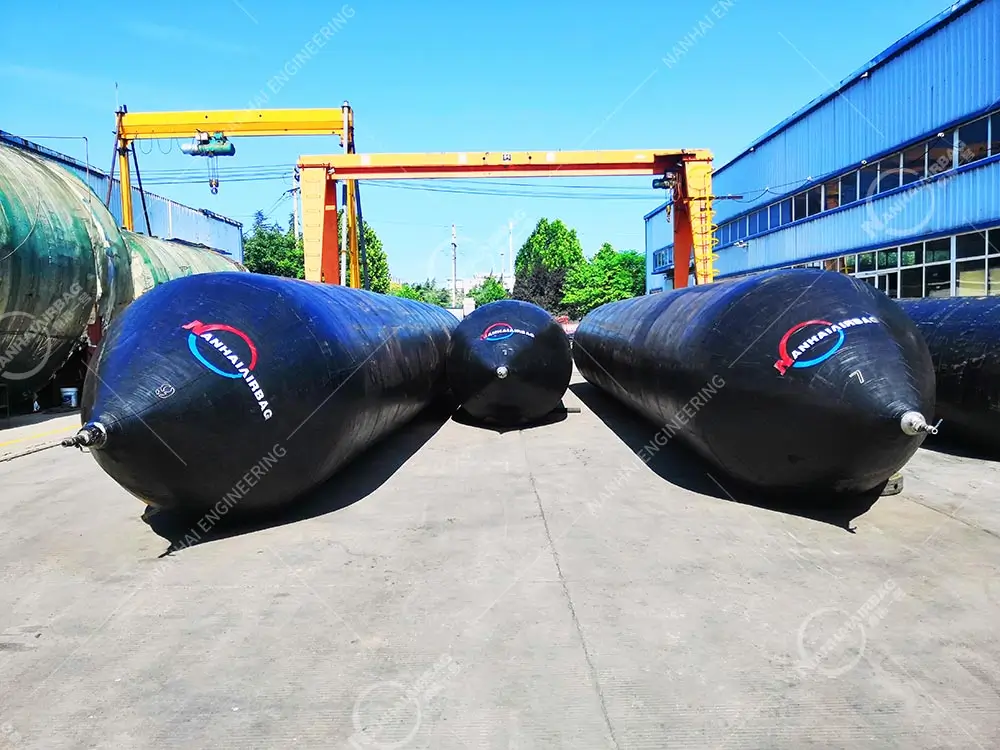What is ship launching airbags
05/15/2025Upgraded version of ship launching airbags: Beenest airbags
05/15/2025How to Maintain Marine Launching Airbags
Proper maintenance of marine launching airbags is essential to ensure their longevity and optimal performance. These inflatable marine airbags, also known as air lift bags or heavy lifting air bags, are critical tools in ship launching, docking, and heavy lifting operations. Neglecting their upkeep can lead to premature wear, operational failures, and increased costs.

1. Regular Inspection and Cleaning
Before and after each use, inspect the airbags for signs of wear, cracks, or damage. Clean the surface to remove dirt and salt deposits, which can cause corrosion. Ensure the airbag is fully dry before storage.
2. Maintain Proper Inflation Pressure
Regularly check and adjust the inflation pressure inside the airbags, ensuring it does not exceed the manufacturer’s recommended maximum pressure. Use an appropriate pressure gauge for accuracy.
3. Avoid Contact with Sharp Objects
Prevent direct contact of the airbags with sharp objects to avoid punctures or surface scratches. Inspect the launch area for debris or sharp items before deployment.
4. Proper Storage
When you’re not using the airbag, make sure to deflate it and keep it stored in a cool, dry spot, away from direct sunlight and extreme temperatures. Avoid contact with corrosive substances such as oils, acids, and alkalis to prevent rubber damage.
5. Lubricate Valves and Fixtures
Periodically lubricate and maintain the valves and connecting parts of the airbags to ensure proper operation and sealing.
6. Maintain Maintenance Records
Keep records of each maintenance and inspection date, operations performed, and any issues or abnormalities discovered. This helps in timely detection and resolution of potential problems.
Repairing Marine Airbags
If damage occurs, follow these steps to repair your marine airbags:
- Clean the Surface: Remove dust, oil, and impurities from the surface of the airbag. Avoid submerging the airbag in water for more than 10 minutes before repairing.
- Inspect and Mark the Damaged Area: Carefully inspect the airbag and mark the area that needs repair. Ensure the repair area extends beyond the visible damage.
- Repair: For longer cracks, use a needle and string to sew up the cracked part of the airbag. Clean the repair area with gasoline and apply a special glue made by mixing raw rubber material with gasoline. Prepare repair rubber material matching the airbag’s outer layer and apply in layers, each larger than the previous.
- Thermal Vulcanization Process: Use heating equipment to heat the patch to ensure the vulcanization of the cracked part of the airbag. Control the temperature at 150 ± 5 degrees Celsius and allow it to cool slowly to 60 degrees Celsius.
- Inspection: After completing the repair, inflate the airbag and observe any air leakage in the repaired area. If any problems are found, make adjustments promptly to ensure that the repaired airbag can be used normally.
Real-World Applications of Marine Airbags
Marine airbags are versatile tools used in various maritime operations:
- Ship Launching: Marine airbags are commonly used to launch ships from slipways, providing a cost-effective and flexible alternative to traditional methods.
- Heavy Lifting: Air lift bags and heavy lifting air bags assist in moving large, heavy objects, such as during ship repairs or construction.
- Salvage Operations: Inflatable marine airbags are employed in salvage operations to refloat sunken vessels or lift submerged structures.
People Also Ask
How often should marine airbags be inspected?
Marine airbags should be inspected before and after each use for signs of wear, damage, or pressure loss. Regular inspections help identify issues early and prevent accidents.
Can marine airbags be repaired if punctured?
Yes, marine airbags can be repaired if punctured. The repair process involves cleaning the damaged area, applying appropriate patches, and performing thermal vulcanization to restore integrity.
Where can I buy high-quality ship launching airbags?
NANHAI has developed marine and engineering airbags that are utilized in various areas such as ship launching, port construction, and tunnel engineering. Additionally, their floating airbags have proven effective in underwater salvage, pipeline laying, box culvert installation, and numerous other floating projects both domestically and internationally.
Are there different types of marine airbags?
Yes, there are various types of marine airbags, including inflatable marine airbags, air lift bags, and heavy lifting air bags, each designed for specific applications in ship launching, lifting, and salvage operations.
Proper maintenance of marine launching airbags is crucial for safe and efficient maritime operations. Regular inspections, correct storage, and timely repairs ensure these tools remain reliable and effective. By following the guidelines outlined above, you can extend the lifespan of your marine airbags and maintain operational safety.
